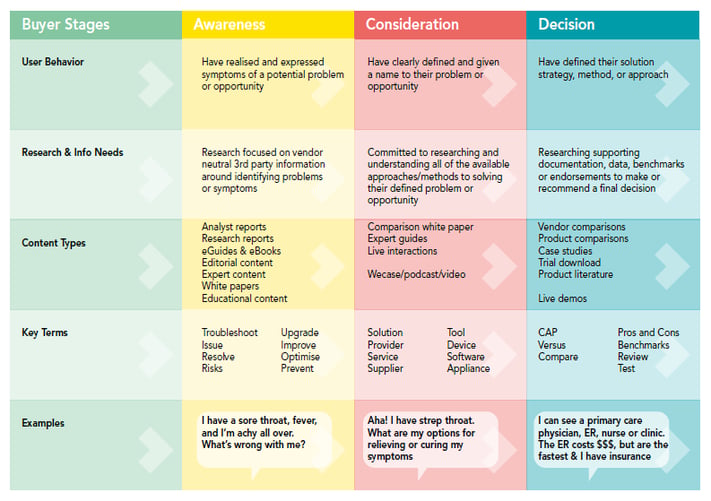Life science marketers have a wide range of tactical choices when it comes to attracting and engaging with their target audiences. However, the rise of the internet has caused a shift in buyer behaviour. No longer do suppliers and sales teams have all the information and hold all the cards. Instead, customers can use the web to research the solutions available and take themselves a large way through the sales process without ever contacting a sales rep. In fact, when they do contact a company, they already know what product they will buy and which supplier they will choose.
So how can we overcome this challenge and influence our prospects during their buying process? A popular method is commonly referred to as content marketing. It has many definitions, but to us it involves creating interesting and engaging content that offers real value to customers through education, entertainment or inspiration. To this end, content marketing is more about building an audience to increase the frequency of touch points with your brand through regular content publishing, rather than solely relying on paid placements such as print and banner ads.
So why use content marketing to reach life science customers such as scientists, doctors, technicians, facility managers, manufacturers and formulation specialists? Well, here are seven reasons why we feel that content marketing could form a powerful part of your strategy and is ideal to connect with life science professionals.
1. Scientists are built to learn and discover
Whether we’re talking about medics, biologists, chemists, physicists or nurses, the entire life science industry is about finding new ways to learn about science and use this knowledge to improve the world around us. They seek out information on their own terms and have the training to sort fact from fiction. You can tap into this process by creating science content that helps to educate them on how to do their jobs more effectively, or by inspiring them, for example to take their research in a new direction. And you don’t need to stop there. Life scientists also love an in-joke, as our blog on this year’s Ig Nobel prizes attests to (it was the most popular blog post on our site last year!). Put simply, scientists are the perfect example of the modern buyer and are much happier seeking and discovering information on their own terms, rather than being overtly sold to by occasionally overeager sales reps.
2. Technical audiences are inherently sceptical
For the likes of scientists, doctors and engineers, success at work is all about paying attention to the details and being sceptical of something if there is no data to back it up. High value content like whitepapers, case studies and technical notes are a perfect opportunity to demonstrate your expertise and the value offered by your products in enough detail to convince a sceptical target. This is particularly true when providing examples (and data) demonstrating the benefits offered by your approach.
3. Reviewing (and acting on) technical content is an inherent part of a scientist’s job
Most people working in the life science sector are required to stay up-to-date with the literature. This can range from reading peer-reviewed research papers and medical journals reporting clinical trial data through to trade magazines reporting on the latest ways to improve production efficiency. Why not make their job even easier by creating content that provides them with knowledge and insights that will help them to do their job even better?
.jpg?width=400&height=267&name=Content%20marketing%20written%20on%20note%20pad%20(comp).jpg)
Image: Patpitchaya/Shutterstock
4. Scientists respect technical expertise and a like-minded attitude
Whether you’re targeting biomedical scientists, medics, academics or industrial scientists, they all share something in common – they have been trained to respect, learn from and value peer-to-peer discussion around their specialist subject. If you can position your team as peers and colleagues in the pursuit of scientific knowledge, you’ll go a long way towards attracting their attention and engaging with them. Have your technical experts author content exploring best practices, current and future trends or even defying the current status quo can be a great way to start a conversation with your target customers. Even better, you can tap into the expertise of your customer base, and work with them on collaborative content projects (after all, there is nothing more effective in life science marketing than third party validation from a happy customer).
5. People don’t like to be sold to, they like to make up their own minds
Most people don’t like to be sold to, but life science audiences tend to be more cynical than most and can spot ‘sales speak’ from a mile away. For this reason, content marketing offers an opportunity to let prospects convince themselves of your expertise and the value offered by your products/services. In our experience, this approach works very effectively (and has done for years, see point 6 below).
6. Content marketing has been a successful tactic in life science for many years
Content marketing has a proven pedigree in the life science market and has always been an effective approach (even if some companies didn’t realise they were doing it). For example, many companies produce new application notes and technical articles each year, detailing how their products can be used for a given application (often backed up by data to show the effectiveness of the approach). Whitepapers, peer-reviewed papers, posters and even conference talks have long been a part of the life science marketer’s toolbox.
What’s different now is that these marketers are starting to plan their content programmes in a more strategic way. For example, they set themselves SMART goals around their content marketing programmes and build ‘content funnels’ designed to attract new leads and nurture them through the buying process (see the figure below).

7. Content can also be used to make some outbound tactics more effective
Are prospects tuning out your outbound marketing? Not opening your emailers? Not clicking on your banner ads? You’re not alone. While some of these trends will be hard to reverse, over the last two years we’ve noticed that using high value content such as an ebook or whitepaper as the call to action in paid outbound campaigns can improve performance (e.g. increase third party email open and click through rates). Although we realise that it may be hard for some companies to do (and we realise the desire to focus on overtly selling products is often just too hard to resist!), we recommend using content to drive some of your third party paid lead capture programmes. One small caveat: by definition, these leads won’t be ready to buy, but they will have started to buy into your expertise. To convert them into customers, you’ll also need to have an effective lead nurturing strategy in place.
Conclusion
Life science audiences place great emphasis on technical understanding and expertise. Demonstrating you’re a reliable and trustworthy source, usually with data to back up your claims, is an important part of establishing credibility with them. Fortunately, you probably have technical specialists you can tap into today, turning their insights into content that drives awareness, positions your company as a thought leader and helps you capture leads to nurture into sales.
How can you get started? We can help. BioStrata is a specialist scientific marketing agency and our core skillset revolves around creating compelling technical content that is both scientifically accurate and engaging (not always an easy feat in the life science sector!). Our team is underpinned by PhD level expertise that allows us to connect with your technical specialists and customers on a peer-to-peer basis. Contact us to get started.
How to get started with content marketing
If you'd like to learn more about exactly what content marketing is, why it can work for life science companies and how to get started, check out our new ebook: The Life Science Marketer's Guide to Content Marketing.





